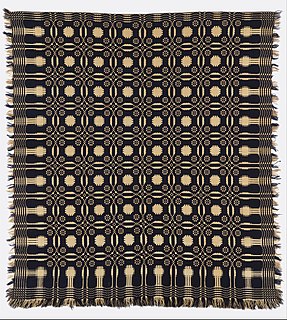
Lenore Tawney was an American artist known for her drawings, personal collages, and sculptural assemblages, who became an influential figure in the development of fiber art.

Haystack Mountain School of Crafts, commonly called "Haystack," is a craft school located at 89 Haystack School Drive on the coast of Deer Isle, Maine.
PlayMakers Repertory Company is the professional theater company in residence at the University of North Carolina at Chapel Hill. PlayMakers Repertory Company is the successor of the Carolina Playmakers and is named after the Historic Playmakers Theatre. PlayMakers was founded in 1976 and is affiliated with the Dramatic and performing arts at the University of North Carolina at Chapel Hill. The company consists of residents, guest artists, professional staff and graduate students in the Department for Dramatic Arts at UNC and produces seasons of six main stage productions of contemporary and classical works that run from September to April. PlayMakers Repertory Company has a second stage series, PRC², that examines controversial social and political issues. The company has been acknowledged by the Drama League of New York and American Theatre magazine for being one of the top fifty regional theaters in the country. PlayMakers operates under agreements with the Actors' Equity Association, United Scenic Artists, and the Society of Stage Directors and Choreographers.
Hunter Library is the university library at Western Carolina University and is located in Cullowhee, North Carolina. Hunter Library supports Western Carolina University's mission of teaching and learning. The Library provides intellectual content, and services related to its discovery and use, for the learning, teaching, and research activities of the University's students, faculty, and staff. By supporting the acquisition of learning and the production of knowledge and scholarship, Hunter Library intends to inspire the individual and the intellect, fostering professional, personal and social growth.

George Masa, born Masahara Izuka, in Osaka, Japan, was a businessman and professional large-format photographer.

A woven coverlet or coverlid is a type of bed covering with a woven design in colored wool yarn on a background of natural linen or cotton. Coverlets were woven in almost every community in the United States from the colonial era until the late 19th century.
Settlement schools are social reform institutions established in rural Appalachia in the early 20th century with the purpose of educating mountain children and improving their isolated rural communities.

Katherine Rebecca Pettit was an American educator and suffragist from Kentucky who contributed to the settlement school movement of the early 20th century.

Valle Crucis Episcopal Mission, also known as Valle Crucis Conference Center, is a historic Episcopal mission church complex and national historic district located near Valle Crucis, Watauga County, North Carolina. The Gothic Revival style, gable-front stone Church of the Holy Cross was built about 1924. Other contributing resources are the church cemetery with the earliest burial dated to 1808, Auchmutv Hall dormitory (1910-1911), The Annex, "The Farm House" (1915), Former Dairy Barn, Former Apple Barn, The Mission House (1896), the Power Dam (1903-1930), the Valley / Field, and the Apple Orchard. The Valle Crucis Episcopal Mission was established by the Episcopal Church in 1844-1845.
Cristina Córdova is an American-born, Puerto Rican sculptor who works and lives in Penland, North Carolina.
Polly Barton is an American textile artist. She was born in New York City. As a student she studied art history at Barnard College and has lived and traveled in Paris, Florence, and Rome. In 1981, she moved to Kameoka, Japan, to study with master weaver Tomohiko Inoue, living in the religious heart of the Oomoto Foundation. She returned to New York in 1982 and continued to weave on her Japanese tsumugi silk kimono looms.

Penland is an unincorporated community in Mitchell County, North Carolina, United States. Penland is 2.9 miles (4.7 km) west-northwest of Spruce Pine. Approximately 200 year-round residents live in the community, the center of which is the Penland Road bridge crossing the North Toe River and CSX railroad line.
Bhakti Ziek is an American artist known for narrative weavings incorporating contemporary jacquard technology. She has been active in the contemporary fiber field for over four decades as an artist, author, teacher and lecturer. Ziek currently resides in Randolph, Vermont.
Cynthia Schira is an American textile artist and former university professor. Her work is represented in the collections of many major public museums.
Mary Meigs Atwater was an American weaver. She revived handweaving in America by collecting weaving drafts, teaching and writing; Handweaver and Craftsman called Atwater "the grand dame and grand mother of the revival of handweaving in [the United States]".
Susie Ganch is a first generation American artist of Hungarian heritage. She is a sculptor, jeweler, educator, and founder and director of Radical Jewelry Makeover.
Susan Morgan Leveille is a weaver and teacher from Dillsboro, North Carolina. Part of a long line of weavers and educators in the state, Morgan has been a central figure in the craft movement in western North Carolina. In 2014 Leveille received a North Carolina Heritage Award from the North Carolina Arts Council in honor of her work.

Lottie Queen Stamper was an American Cherokee basket weaver and educator.
Suzie Liles is an American fiber artist, master weaver, the owner of the Eugene Textile Center and co-owner of Glimakra USA, in Eugene, Oregon.










